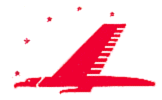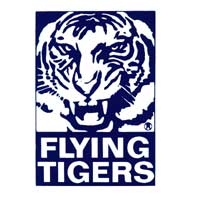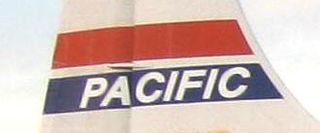Related Research Articles

Western Airlines was a major airline in the United States based in California, operating in the Western United States including Alaska and Hawaii, and western Canada, as well as to New York City, Boston, Washington, D.C., and Miami and to Mexico City, London and Nassau. Western had hubs at Los Angeles International Airport, Salt Lake City International Airport, and the former Stapleton International Airport in Denver. Before it merged with Delta Air Lines in 1987 it was headquartered at Los Angeles International Airport (LAX). Throughout the company's history, its slogan was "Western Airlines...The Only Way to Fly!"

Hollywood Burbank Airport, formerly called Bob Hope Airport after entertainer Bob Hope, is a public airport three miles (4.8 km) northwest of downtown Burbank, in Los Angeles County, California, United States. The airport serves Burbank, Hollywood, and the northern Greater Los Angeles area, which includes Glendale, Pasadena, the San Fernando Valley and the Santa Clarita Valley. It is closer to many popular attractions, including Griffith Park, Universal Studios Hollywood, and Downtown Los Angeles, than Los Angeles International Airport (LAX), and it is the only airport in the area with a direct rail connection to Downtown Los Angeles, with service from two stations: Burbank Airport–North and Burbank Airport–South. Nonstop flights mostly serve cities in the western United States, though JetBlue has daily flights to New York City. Southwest also occasionally flies non regular routes to the East Coast.

American Airlines Flight 965 was a regularly scheduled flight from Miami International Airport in Miami, Florida, to Alfonso Bonilla Aragón International Airport in Cali, Colombia. On December 20, 1995, the Boeing 757-200 flying this route crashed into a mountain in Buga, Colombia, around 9:40 pm killing 151 of the 155 passengers and all eight crew members.

The Boeing Model 247 is an early American airliner, and one of the first such aircraft to incorporate advances such as all-metal semimonocoque construction, a fully cantilevered wing, and retractable landing gear. Other advanced features included control surface trim tabs, an autopilot and de-icing boots for the wings and tailplane. The 247 first flew on February 8, 1933, and entered service later that year.
This is a list of aviation-related events from 2000.

Martin Elmer Johnson and Osa Helen Johnson were married American adventurers and documentary filmmakers. In the first half of the 20th century the couple captured the public's imagination through their films and books of adventure in exotic, faraway lands. Photographers, explorers, marketers, naturalists and authors, Martin and Osa studied the wildlife and peoples of East and Central Africa, the South Pacific Islands and British North Borneo. They explored then-unknown lands and brought back film footage and photographs, offering many Americans their first understanding of these distant lands.

Capital Airlines was a United States trunk carrier, a scheduled airline serving the eastern, southern, southeastern, and midwestern United States. Capital's headquarters were located at Washington National Airport across the Potomac river from Washington, D.C., where crew training and aircraft overhauls were also accomplished. In the 1950s Capital was the fifth largest United States domestic carrier by passenger count after the Big Four air carriers.

Flying Tiger Line, also known as Flying Tigers, was the first scheduled cargo airline in the United States and a major military charter operator during the Cold War era for both cargo and personnel. The airline was bought by Federal Express in 1988.
On October 10, 1933, United Air Lines Trip 23, a Boeing 247 airliner operated by United Air Lines and registered as NC13304 crashed near Chesterton, Indiana, United States. The transcontinental flight carried three crew and four passengers and originated in Newark, New Jersey, with its final destination in Oakland, California. It had already landed in Cleveland, and was headed to its next stop in Chicago when it exploded en route. All aboard died in the crash, which was caused by an on-board explosive device. Eyewitnesses on the ground reported hearing an explosion shortly after 9 pm and seeing the aircraft in flames at an altitude around 1,000 feet (300 m). A second explosion followed after the aircraft crashed. The crash scene was adjacent to a gravel road about 5 miles (8 km) outside of Chesterton, centered in a wooded area on the Jackson Township farm of James Smiley.

Pacific Air Lines was a local service carrier on the West Coast of the United States that began scheduled passenger flights in the mid-1940s under the name Southwest Airways. The company linked small cities in California with larger cities such as Los Angeles and San Francisco. Flights later operated to Portland, Oregon, and eventually reached Las Vegas and Reno in Nevada.

Southwest Airlines Flight 1455 was a scheduled passenger flight from McCarran International Airport, Las Vegas, Nevada, to Burbank-Glendale-Pasadena Airport, Burbank, California, that overran the runway during landing on March 5, 2000. The aircraft, a Boeing 737-3T5, registration N668SW, came to rest on a city street adjacent to a gas station. The National Transportation Safety Board found that the incident was due to the pilots attempting to land with excessive speed. They also found that the air traffic controller placed them in a position from which their only option was a go around. Two of the passengers were seriously injured, and there were many minor injuries. As a result of the incident, the airport installed an Engineered Materials Arrestor System at the east end of the incident runway. The aircraft was written off, making the incident the 10th hull loss of a Boeing 737-300. This was the first major accident in the airline's 29-year history.
TWA Flight 3 was a twin-engine Douglas DC-3-382 propliner, registration NC1946, operated by Transcontinental and Western Air (TWA) as a scheduled domestic passenger flight from New York, New York, to Burbank, California, in the United States, via several stopovers including Las Vegas, Nevada. On January 16, 1942, at 19:20 PST, fifteen minutes after takeoff from Las Vegas Airport bound for Burbank, the aircraft was destroyed when it crashed into a sheer cliff on Potosi Mountain, 32 miles (51 km) southwest of the airport, at an elevation of 7,770 ft (2,370 m) above sea level. All 22 people on board, including movie star Carole Lombard, her mother, and three crew members, died in the crash. The Civil Aeronautics Board (CAB) investigated the accident and determined that the cause was a navigation error by the captain.

United Air Lines Flight 34 was a scheduled flight departing from San Francisco to Los Angeles, California, on December 27, 1936. At 7:36 am, the co-pilot requested the UAL localizer beacon at Burbank be turned on. The company radio requested aircraft position, to which the co-pilot replied, "just a minute." The aircraft crashed at the head of Rice Canyon at 7:38 am, killing all 12 passengers and crew. The probable cause was found to be "...an error on the part of the pilot for attempting to fly through Newhall pass at an altitude lower than the surrounding mountains without first determining by radio the existing weather."

The Douglas DC-2 is a 14-passenger, twin-engined airliner that was produced by the American company Douglas Aircraft Company starting in 1934. It competed with the Boeing 247. In 1935, Douglas produced a larger version called the DC-3, which became one of the most successful aircraft in history.

Standard Air Lines Flight 897R was a domestic passenger flight between Albuquerque, New Mexico and Burbank, California. At 7:43am on July 12, 1949, the flight, operated by a Curtiss C-46E, crashed in Chatsworth, California, upon approach to Burbank, killing 35 of the 48 passengers and crew on board.
References
- ↑ PlaneCrashInfo
- ↑ "Transport: Wreck and Radio". Time. 1937-01-25. ISSN 0040-781X . Retrieved 2023-02-15.
- 1 2 3 "Report of the Accident Board; Western Air Express near Newhall, California, on January 12, 1937". Department of Commerce. May 12, 1937. Retrieved June 1, 2021. – PDF
- ↑ Kansas State Historical Society - Profile of Osa Johnson
- ↑ Osa Johnson Loses Appeal, Los Angeles Times, July 1, 1941, p. A14 - brief excerpt. Clip at Newspapers.com.
- ↑ "Osa Johnson Loses Appeal in Lawsuit Over Mate's Death". The Long Beach Sun . Long Beach, California. United Press International. 1941-08-29. p. A-3. - Clip at Newspapers.com.